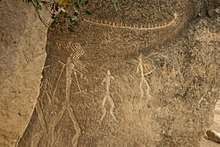Quba Khanate
The Quba Khanate was a quasi-independent Safavid khanate, under Iranian suzerainty[1] on the territory of the modern-day Republic of Azerbaijan from 1726–1806. The Quba Khanate was founded in the mid-1680s by Hoseyn Khan. He was the sole survivor of the massacre around 1665, when the Majales branch of the ruling Usmi family of the Qaytaq killed the Yeki-kend branch. Hoseyn Khan was a small boy who was smuggled to Iran by a few family retainers. He stayed at Shah Soleyman's court and returned to his homeland in the mid-1680s and settled in Quba where he built Ft. Khudadad.

Part of a series on the |
|---|
| History of Azerbaijan |
 |
|
Antiquity |
|
Middle Ages
|
|
Early modern history
|
|
|
In 1689, he came to Bashli and took back the hereditary governorship from ‘Ali Soltan Usmi of the Yeki-kand branch. He was evicted by his relatives, but his son Ahmad took Bashli in 1706 where he ruled until 1710, when the rival Majales branch of the family killed him. Under Nader Shah (1736-47) Hoseyn Khan son of Ahmad became governor of Qubeh and Saliyan. Hoseyn Khan was well respected, and although under his son, Fath Ali Khan, his daughter married the Usmi (the chief of the rival family branch) the relationship remained hostile.
The Khanate achieved quasi-independence after the assassination of Nader Shah in 1747 and achieved its greatest prominence under Fath Ali Khan (Feteli Khan) (1758-1789).
As a result of conquests and successful alliances, Fath Ali Khan seized the important port of Baku, Darband, the Shamakha Khanate and the Salyan Khanate and organized expeditions as far south as Ardabil in his fight against the Zand dynasty.
The Quba Khanate received military assistance from Russia in 1775, when Russia decided to take action against the Usmi of the Qaytaq, who had kidnapped Samuel Gottlieb Gmelin, a German scientist in Russian service and who had died in captivity.
After Fath Ali Khan's death, the Khanate's influence declined. As a result of Mohammad Khan Qajar's conquests and the devastation it had brought, the Alliance of Northern khanates disintegrated. The Khanate was conquered by Russia in 1806, and was fully incorporated into newly created Shamakha Governorate by 1816.[2]
Saytaq Khans Rulers
- 1680 – Sep 1721 Husayn Khan
- 1721 Ahmad Khan
- 1721–1722 Chulaq Surkhay Khan
- 1722–1758 Husayn `Ali Khan
- 1758 – Mar 1789 Fath `Ali Khan
- 1789–1791 Ahmad Khan
- 1791–1806 Shaykh `Ali Agha
- 1806–1816 Husayn Khan
References
- Bournoutian, George A. (2016). The 1820 Russian Survey of the Khanate of Shirvan: A Primary Source on the Demography and Economy of an Iranian Province prior to its Annexation by Russia. Gibb Memorial Trust. p. xvii. ISBN 978-1909724808.
Serious historians and geographers agree that after the fall of the Safavids, and especially from the mid-eighteenth century, the territory of the South Caucasus was composed of the khanates of Ganja, Kuba, Shirvan, Baku, Talesh, Sheki, Karabagh, Nakhichivan and Yerevan, all of which were under Iranian suzerainty.
- Literature: Samuel Gottlieb Gmelin. Travels through Northern Persia 1770-1774 translated and annotated by Willem Floor (Washington DC, MAGE, 2007); Bakikhanov, The Heavenly Rose-Garden. A History of Shirvan & Daghestan translated and annotated by Willem Floor & Hasan Javadi(Washington DC: MAGE, 2010); Willem Floor, “Who are the Shamkhal and the Usmi?” ZDMG 160/2 (2010), pp. 341-81